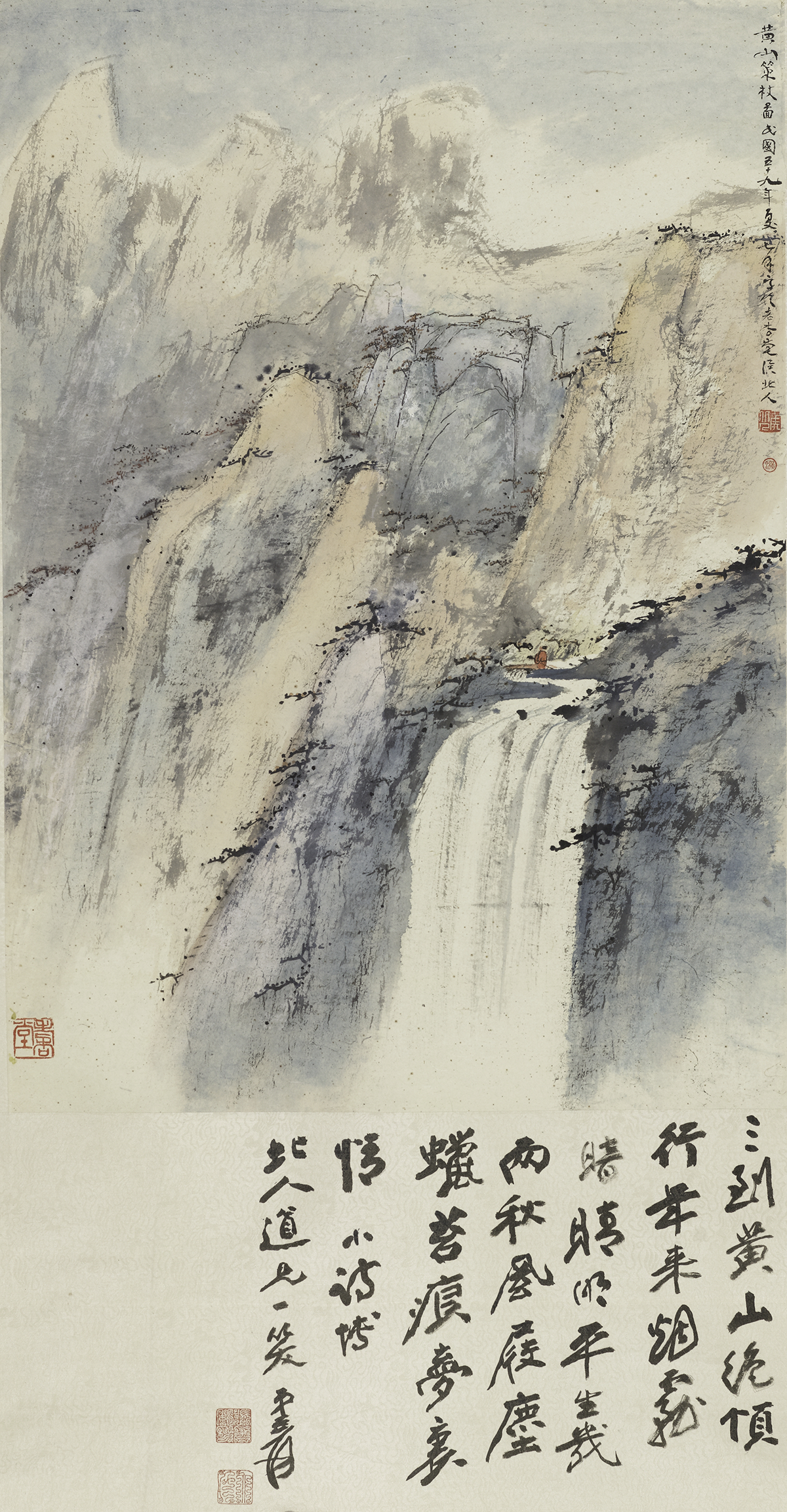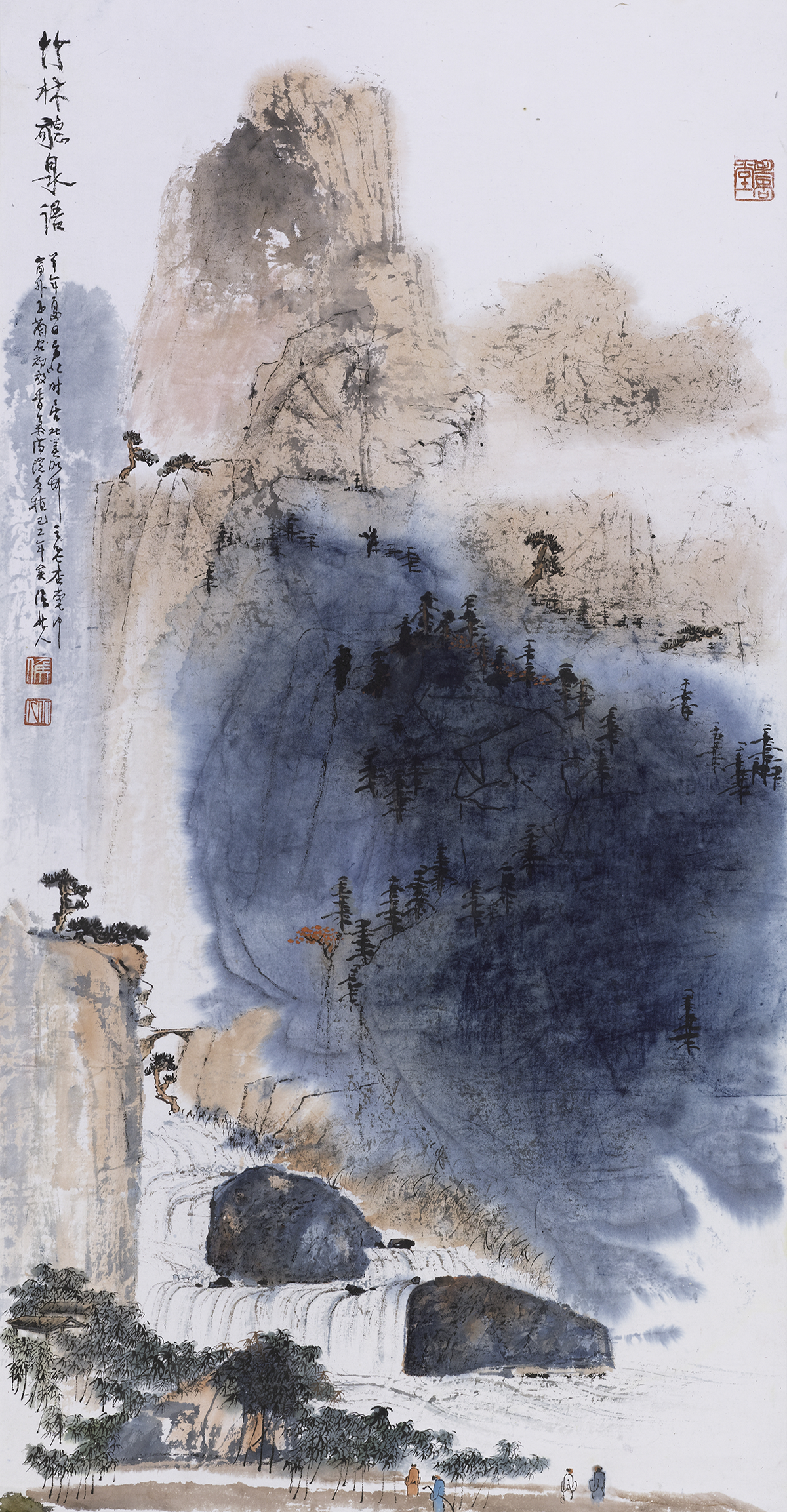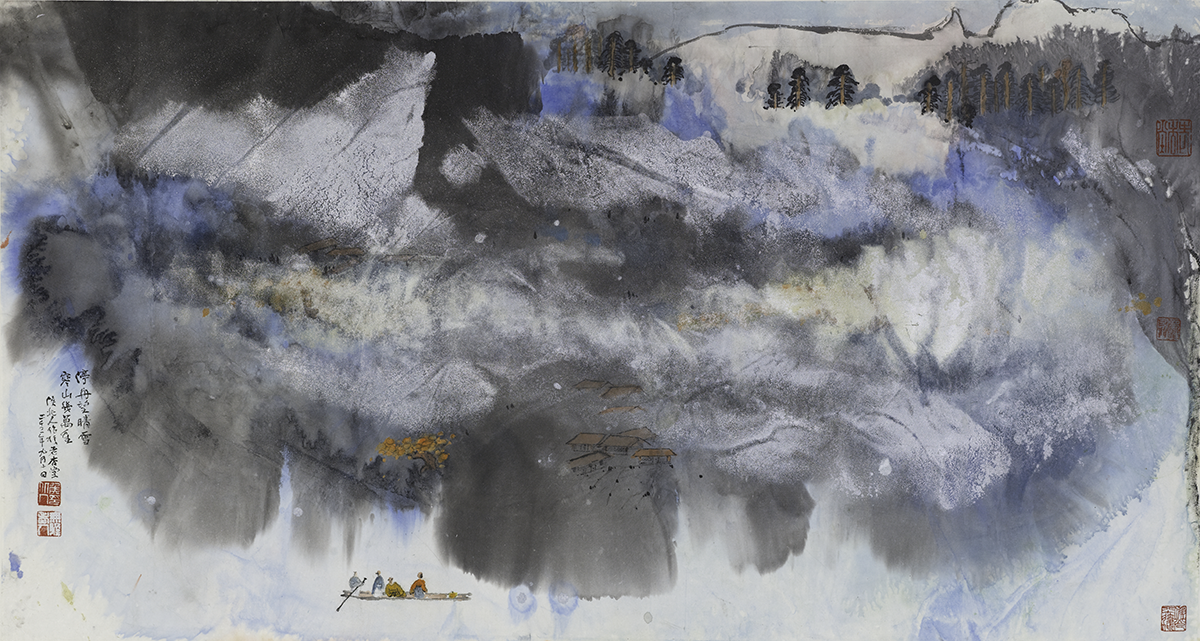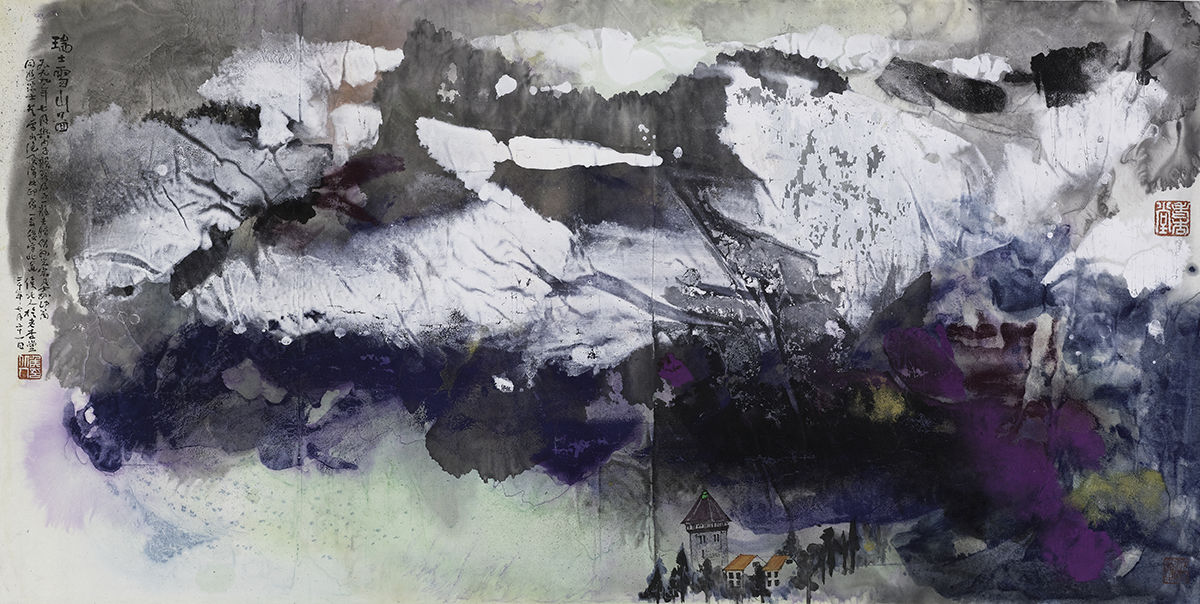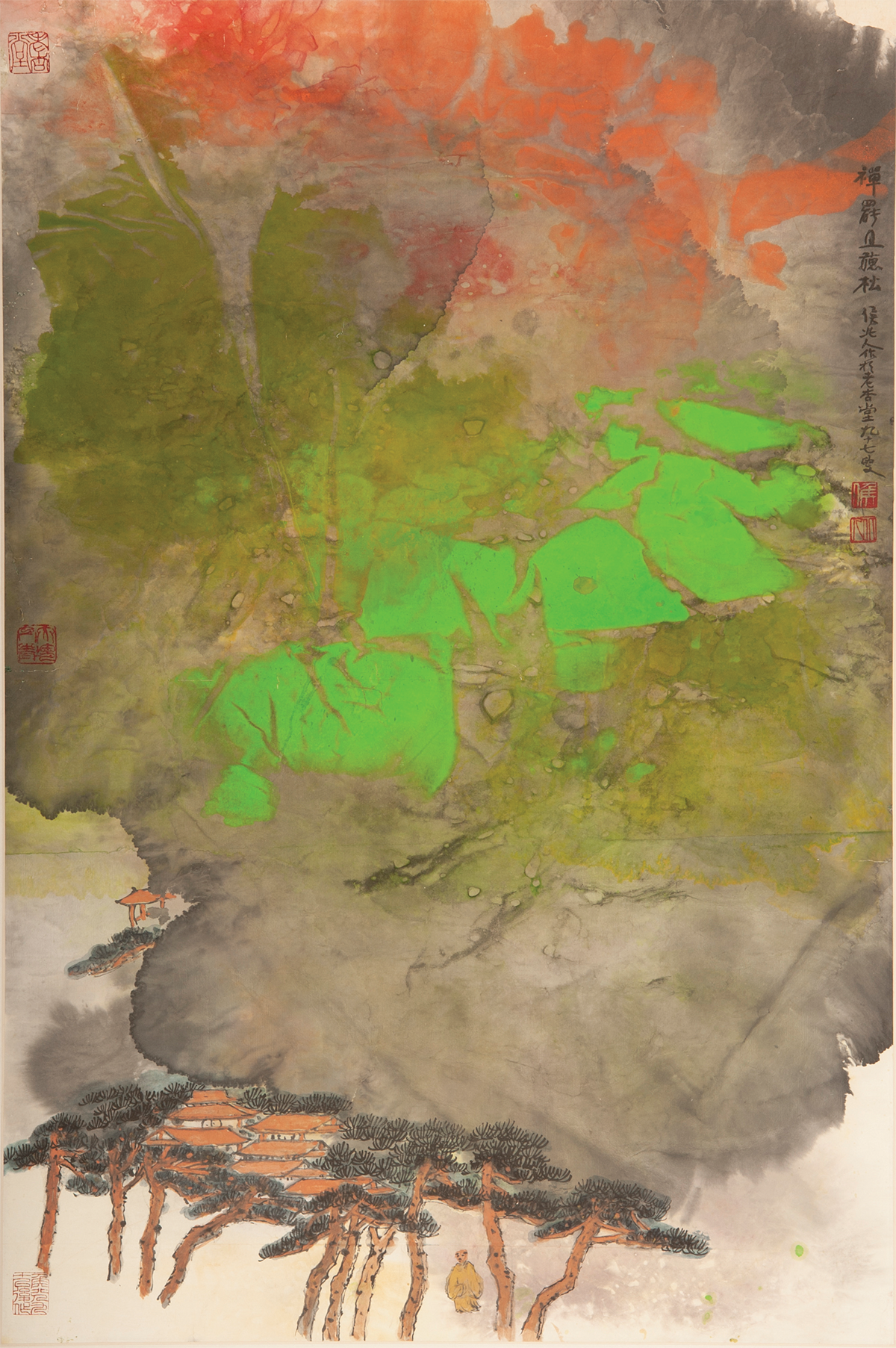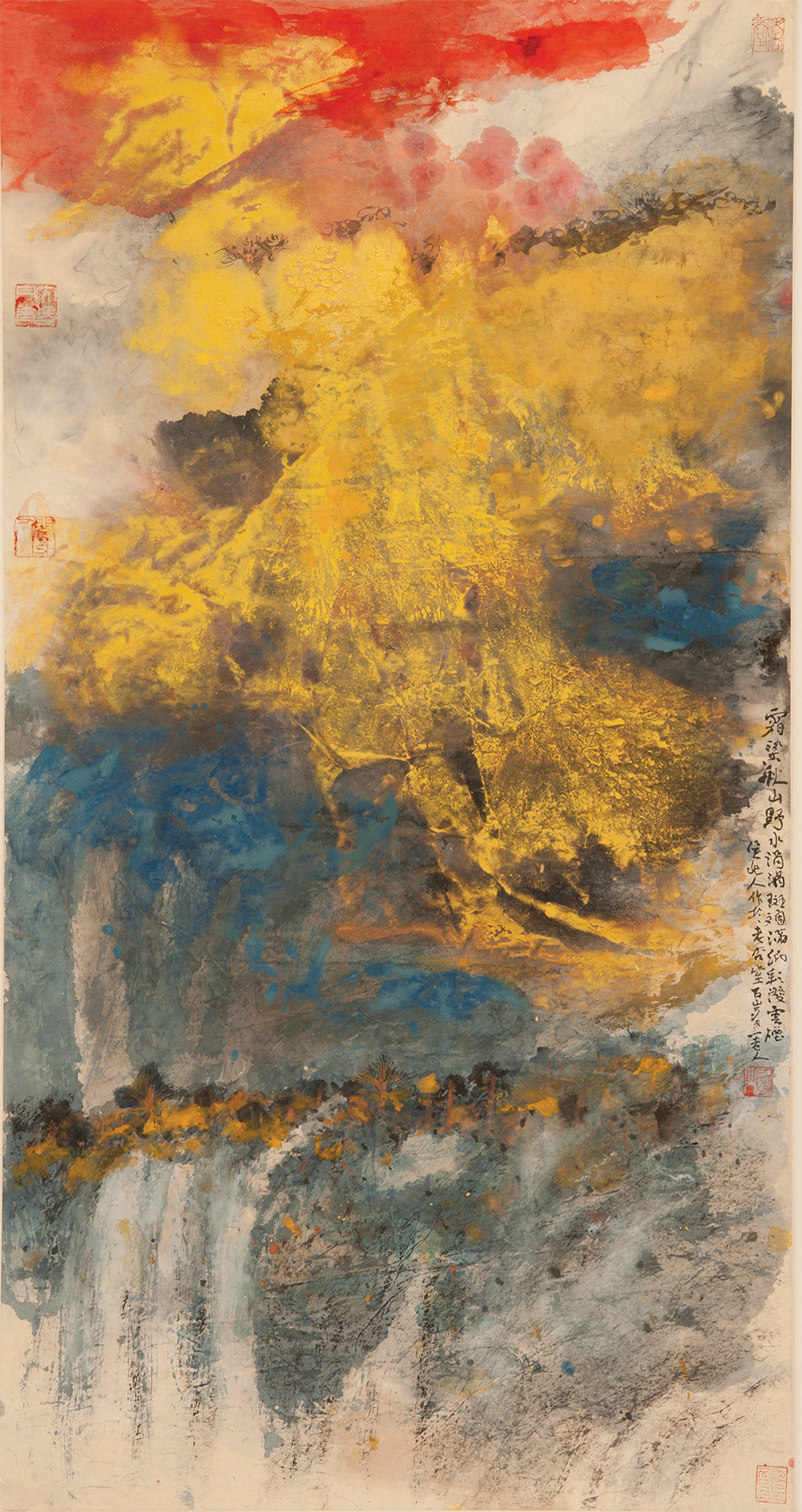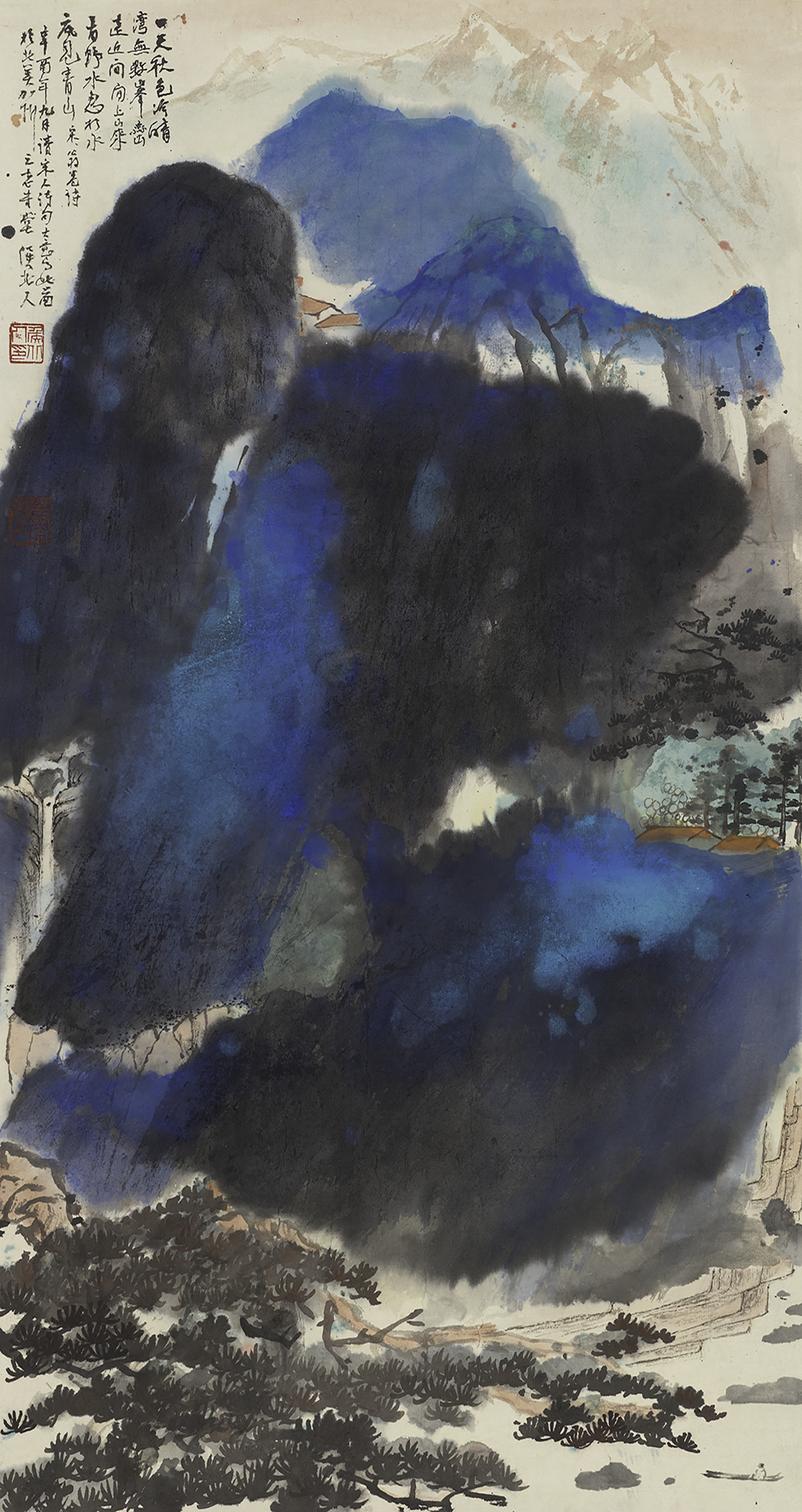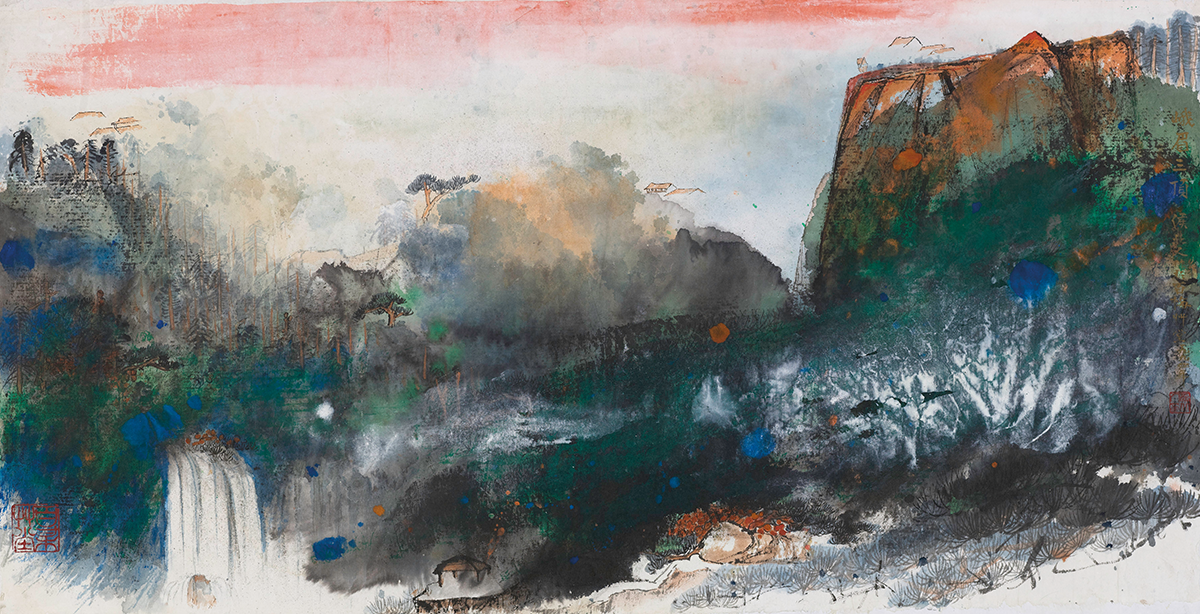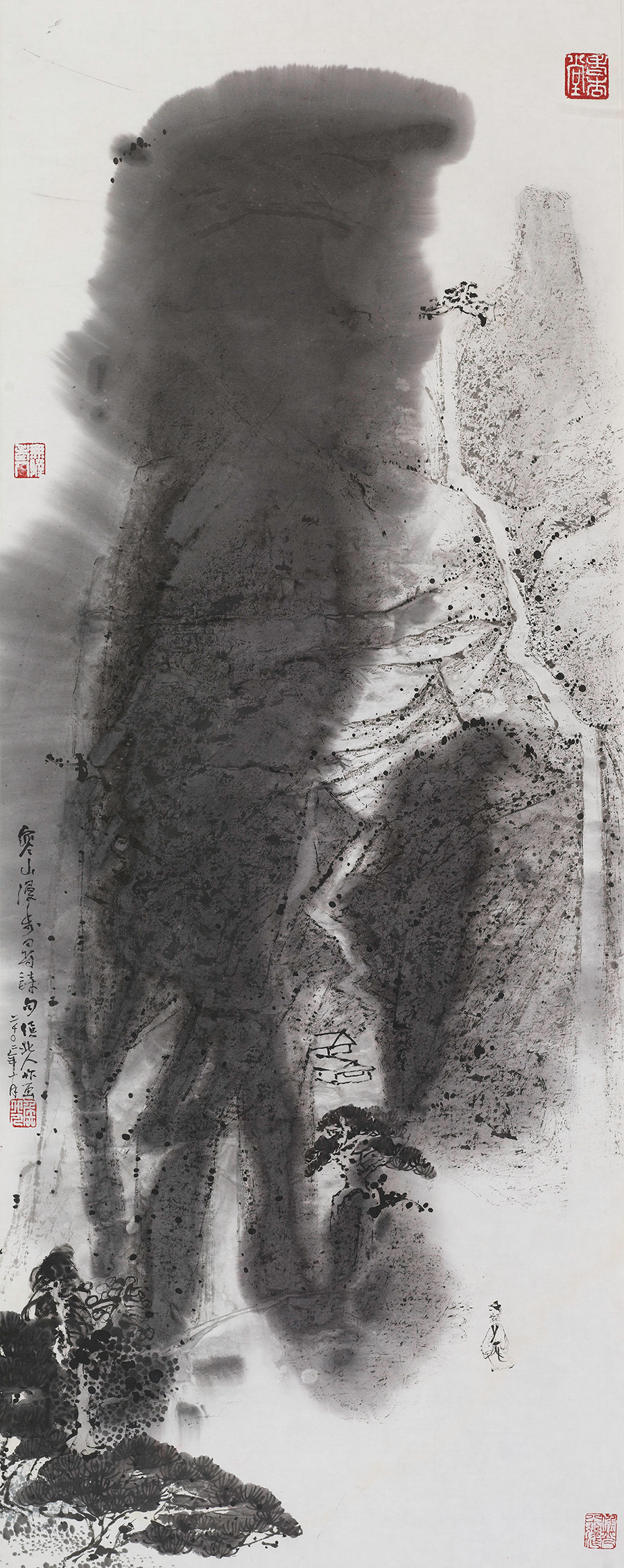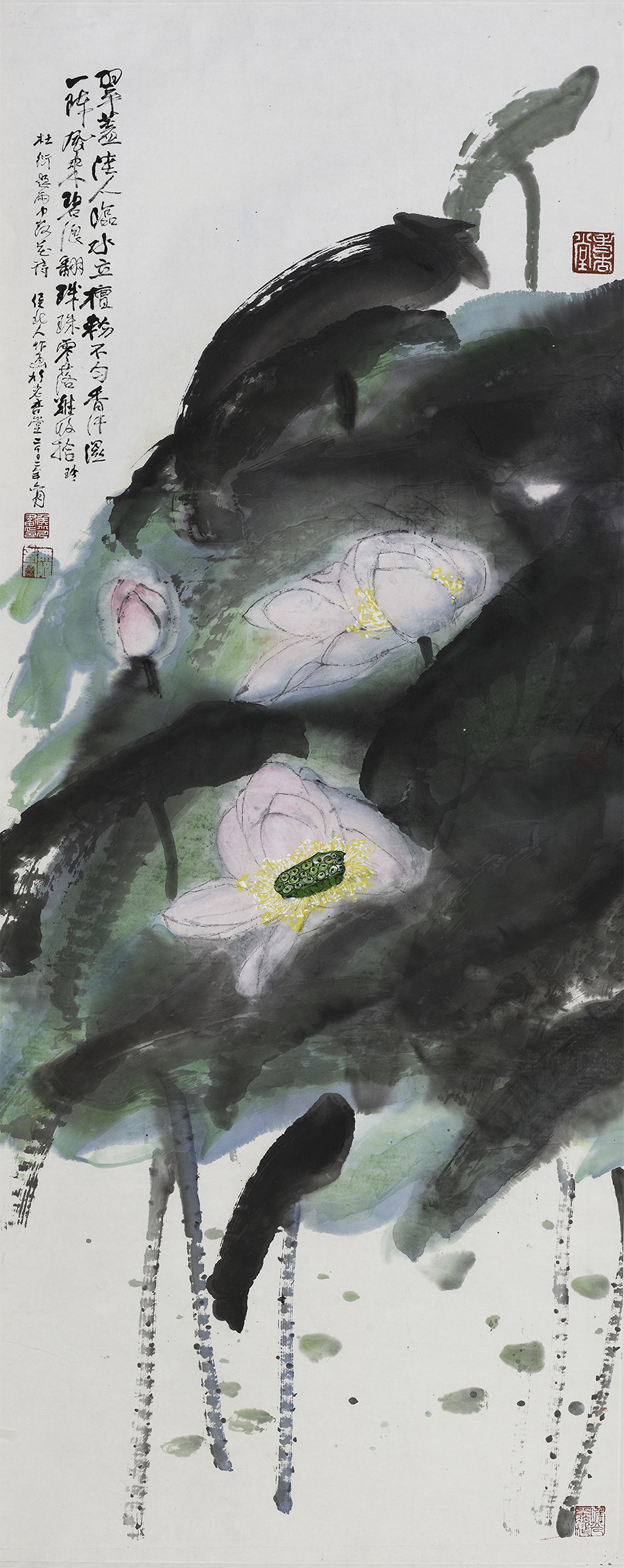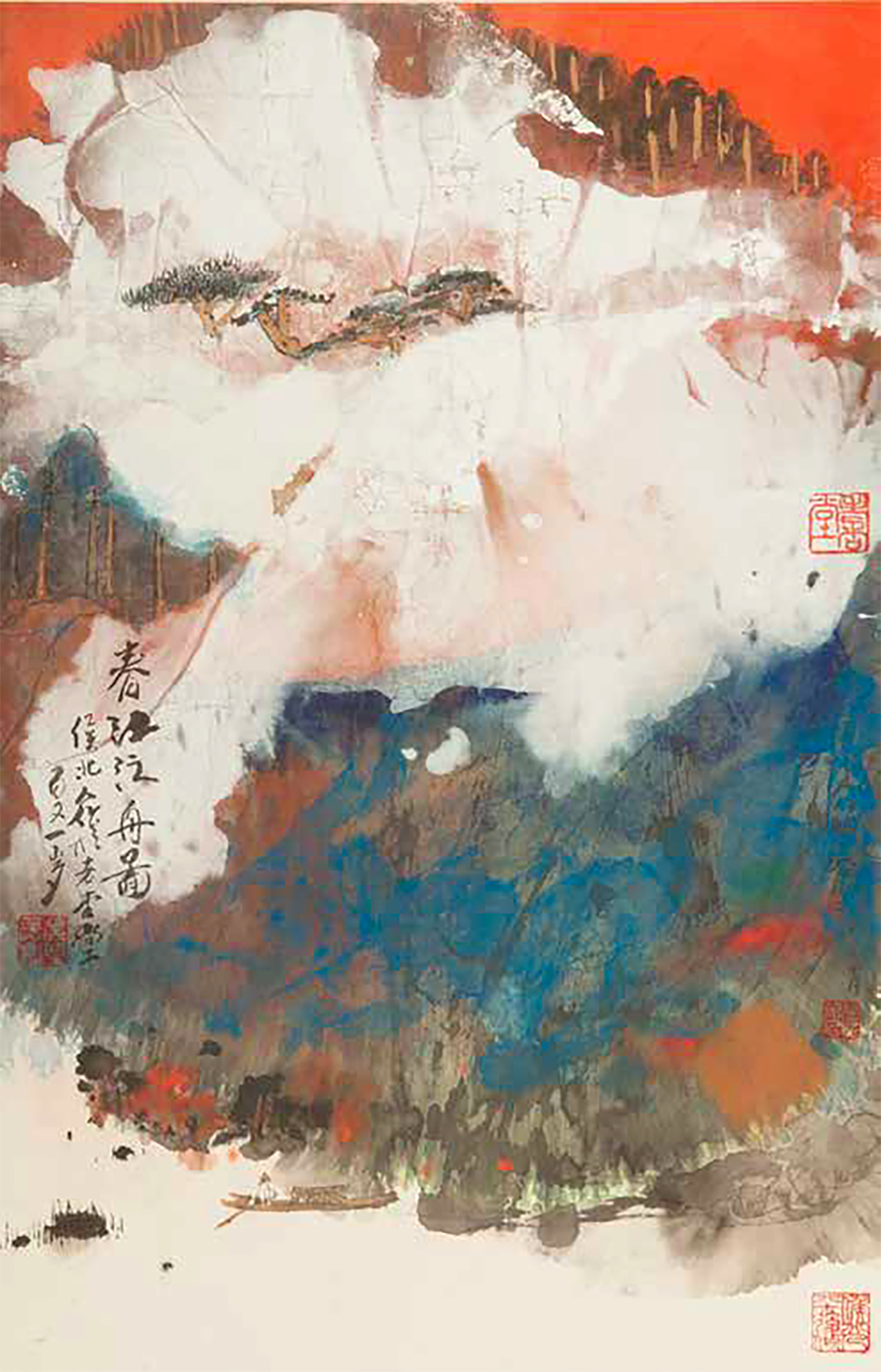7. Hou Beiren's Splashed Ink
Several published examples of Hou’s landscapes dating from the period between the mid-1950s and late 1970s show that he was still producing landscapes in muted and softly rendered blue-grey and earthen tones, with comparatively rough, abbreviated, and textured outlines gradually giving way to the freer and more expressive use of washes.
Paintings from this period share some elements of compositional devices—the use of ink tone texture and dots in brushwork; also subject matter, with the landscape paintings that Huang Binhong (1865–1955) produced throughout the 1930s. Hou had studied briefly with Huang in Beijing during the summers when he returned home from his studies in Japan.1 Landscape painting remained the dominant theme in Hou’s work, and later in life reminiscences of home evoked through titles, inscriptions and seals became a theme to which he would often return.
Within Hou’s work, figurative elements dot his compositions of rivers winding through mountains and forests, along with monumental mountainscapes. In these works, diminutive and isolated figures of wayfarers and mendicants can sometimes be seen picking their way with the aid of a walking staff along remote mountain trails, slowly heading toward some unknown remote destination. Figures drifting in boats gaze up at vast worlds full of pines and mist-shrouded peaks and endless receding ridge lines eclipsing all else.
The human presence in Hou’s monumental landscapes is nearly always rendered insignificant and vastly overshadowed by abstracted painterly evocations of nature, reminiscent of the juxtaposition of man and nature found in Northern Song painting. Hou’s landscape subjects are invariably rooted in the traditional literati painting landscapes of the Yellow Mountain and Jiangnan regions, and occasionally include Northern Californian landscapes such as Yosemite, or Switzerland, in commemoration of a trip he and his family made to the Swiss Alps in 1999.
Hou’s mountain landscapes remain places of retreat and solitude, the dwelling of mountain spirits and immortals (xian), remote mist shrouded Buddhist monasteries and temples, hidden Daoist cave grottoes (dongtian) and isolated mountain hamlets. The figures in his mind landscapes (xiong zhong qiuhuo) wear the scholar’s robes of the literati and gentry of a now vanished imperial past. They are arguably as much the subject as the landscape they appear in, signifying through their presence that these mountain fastnesses belong within the millennia-plus tradition of Chinese landscape imagery of mountains, bamboo, rocks and pines, which are emblematic of the moral standards and ethical values of the literati of imperial China. These figures connote notions of a withdrawal from official life and politics to pursue self-cultivation and spiritual renewal in remote seclusion.
Only occasionally does one see a saffron clad Buddhist monk or fishermen in Hou’s splashed ink mountains and rivers. These monumental landscapes are populated primarily by literati wanderers and ascetic hermits who appear custodian-like of these seemingly changeless landscapes—sites of the well-worn reclusive scholar ideal continuously represented across centuries of literati painting and the decorative arts, but still rich and replete storehouses of history, meaning and metaphor. Hou repeatedly draws inspiration from a range of literary figures from China’s past, some of whom he portrays, using their lines and verses of poetry as creative prompts. These are inscribed on the paintings and, in combination with Hou’s seal imprints, provide the paratextual framing of traditional literati painting practise.
Splashed ink landscapes feature most significantly in Hou Beiren’s artistic practise and output from the late 1970s, and many of the early examples of his work in this mode closely follow Zhang Daqian’s use of intensely saturated washes of blues, aquamarines and greens. In the 1984 catalogue Hou Beiren Huaji (Album of Hou Beiren Paintings), the sixty-one undated paintings are comprised almost entirely of vertiginous landscapes featuring thin, layered washes of ink and colour. A comparatively natural palette comprised of blues, greens and ochre earth tones features heavily.
The relatively small areas of brighter colour first seen in Zhang Daqian’s work, and in Hou’s early splashed ink paintings, expand by the 1990s into larger, looser and more saturated splashes of colour: reds, crimsons, oranges, yellows, bright greens, electric blues and white, as Hou became more and more experimental in both the application of ink and colour in his compositions. In these later paintings, ink and colour are typically gesturally applied or dragged across the painting’s surface in thin and fluid washes, which are then allowed to bleed, puddle and smear, acquiring and building incidental texture, and sometimes creating fibrous capillaries or granular and fractal-like coruscations and scalloped eddies of ink.
In some works, ink is loosely flicked onto the surface to provide a texturing effect of flecks and stippling analogous to the use of dots (dian) in traditional landscape painting, but in a looser style of inkblots and splatters that recalls the work of the Qing painter Shitao (1642–1707), whose influence is evident in Hou’s work. Colour and ink sometimes pool and coalesce into dense fissures and darkly opaque blots resembling umbrous cavities and swirls that recall the primordial energies from which rocks and mountains were believed to be formed in Daoist cosmology. In Hou’s work, the resulting landscapes composed of soft organic forms and ragged patches of ink hover on the edge of complete abstraction only to be pulled back into the realm of the figurative with the addition of delineating strokes or trees, figures and buildings—though these tend to be minimal in scale, serving to anchor and orient the viewer in the composition.
Hou’s technique uses splashed ink in the first stage of the painting to generate a ground of random ink, and a second stage involving the addition of figurative elements through deliberate brushstrokes. Finally, a thin colour wash is added to certain areas of the painting in a third stage to integrate areas of the composition.2 A China Central Television (CCTV) documentary shows footage of Hou painting in his studio, working on a landscape onto which he pours and brushes ink and colour in the gesticulatory first stage, to which in a second stage of more deliberate brushwork he makes figurative additions.3
In recent decades, Hou Beiren’s landscape painting has evolved into a recursive and deeply personal exploration of ink painting, displaying a knowledgeable engagement with traditional Chinese art and literature. The titles and inscriptions of his landscapes refer to poets and literary voices from across the past millennium: sources of inspiration whose work provides the lines and verses used as descriptive prompts.
Although Hou’s work can be seen to deal with the continuity of the ink painting tradition, it no longer takes its primary inspiration from other paintings or painters, but has become concerned with landscapes of interiority and memory—an individualist art determined not by location but by cultural identity; a cultural identity bound by memory and remaining exclusively rooted in a Chinese vision of nature and landscape.
Over the years his landscapes have become almost metaphysical and fantastical in conception, as fabulous as Penglai, the mythical island of the abode of immortals, or the fabled Peach Blossom Spring (Taohua yuan). Now in his second century, Hou Beiren has continued to paint and to experiment in his work ‘seeking change’ (qiu bian) in the words of one of his recent seals, in the latest stage of a lifelong and intensely personal artistic pilgrimage in ink.
Notes
-
See Hou Beiren meishuguan 2014 vol. 2: 275–280. Given the brevity of Hou’s period of study with Huang, combined with the comparatively few published paintings of Hou’s dating from the 1960s and 1970s, a more systematic comparison is not possible. ↩︎
-
Yang 1998: 14. ↩︎
-
The program entitled Hou Beiren Danqing Canran (侯北人丹青燦然) Hou Beiren’s Brilliant Painting, aired on 2 April 2014. Accessed May 17, 2019. ↩︎
